#Top Data Modeling Tools
Explore tagged Tumblr posts
Text
Best Data Modeling Tools: Which One is Right for Data Analysis?

Data modeling is a crucial aspect of data analysis, as it lays the foundation for organizing, managing, and utilizing data effectively. The right data modeling tool can streamline this process, making it easier to design and manage databases, understand relationships between data, and ultimately drive insights. With numerous data modeling tools available, choosing the right one can be challenging. This article will explore some of the best data modeling tools and help you determine which one is right for your data analysis needs.
What is Data Modeling?
Data modeling is the process of creating a visual representation of a system or database. It involves defining the structure of data, relationships, constraints, and more. Data modeling helps organizations to understand their data better, leading to more informed decision-making. It’s a critical step in database design, ensuring that data is stored efficiently and can be retrieved easily when needed.
Why is Data Modeling Important?
Data modeling plays a vital role in the accuracy and efficiency of data analysis. It helps in:
Understanding Data Relationships: Modeling reveals how different data elements interact with each other.
Improving Data Quality: Proper data modeling can help in maintaining data integrity and consistency.
Facilitating Data Integration: It aids in integrating data from different sources, making it accessible for analysis.
Enhancing Communication: A clear model makes it easier for stakeholders to understand complex data structures.
Top Data Modeling Tools for Data Analysis
1. ER/Studio
ER/Studio is a powerful tool for enterprise data modeling. It offers a range of features such as reverse engineering, forward engineering, and collaboration tools. ER/Studio is known for its ease of use and robust set of functionalities, making it a favorite among large enterprises. Its ability to support complex data models and integrate with various database management systems makes it an excellent choice for large-scale data analysis projects.
Key Features:
Comprehensive data lineage and impact analysis.
Collaboration capabilities for team-based projects.
Support for multiple database platforms.
2. IBM InfoSphere Data Architect
IBM InfoSphere Data Architect is another leading data modeling tool, particularly suited for large organizations. It provides a collaborative environment for designing and managing data models. With robust integration with IBM’s other data management products, this tool is ideal for businesses already invested in IBM’s ecosystem.
Key Features:
Data integration and lifecycle management.
Metadata management and version control.
Automated database design and optimization.
3. Oracle SQL Developer Data Modeler
Oracle SQL Developer Data Modeler is a free tool that offers a wide range of features for designing, creating, and analyzing data models. It supports various data modeling techniques, including logical, relational, and physical data models. Its seamless integration with Oracle databases makes it an excellent choice for organizations using Oracle products.
Key Features:
Support for different data modeling methodologies.
Integration with Oracle databases for smooth operations.
Import and export capabilities for different file formats.
4. Lucidchart
Lucidchart is a versatile diagramming tool that also serves as a capable data modeling tool. It’s cloud-based, making it accessible from anywhere, and its intuitive interface allows users to create data models with ease. While it may not have the advanced features of some other tools, it’s perfect for smaller teams or those looking for a simple solution.
Key Features:
Easy-to-use drag-and-drop interface.
Real-time collaboration for teams.
Extensive template library for quick model creation.
5. Toad Data Modeler
Toad Data Modeler is a comprehensive tool that supports a variety of database platforms. It offers a range of functionalities, including reverse engineering, forward engineering, and model validation. Toad is well-known for its user-friendly interface and powerful automation features, making it suitable for both beginners and experienced users.
Key Features:
Multi-database support.
Automated model creation and optimization.
Advanced data analysis and reporting tools.
Choosing the Right Tool for Your Needs
Selecting the right data modeling tool depends on several factors, including your organization’s size, the complexity of your data models, your existing technology stack, and your budget.
For Large Enterprises: Tools like ER/Studio and IBM InfoSphere Data Architect are ideal, offering robust features and scalability.
For Oracle Users: Oracle SQL Developer Data Modeler is a natural fit, providing seamless integration with Oracle databases.
For Small Teams: Lucidchart offers an easy-to-use, cloud-based solution that’s perfect for smaller teams or less complex projects.
For Versatility: Toad Data Modeler supports multiple databases and offers a balance between ease of use and advanced features.
Conclusion
Choosing the right data modeling tool is crucial for effective data analysis. Each tool has its strengths and is designed to cater to different needs. By understanding your specific requirements and the features offered by each tool, you can select the one that best aligns with your data analysis goals. Whether you need a tool for a large enterprise or a simple solution for a small team, the right data modeling tool can significantly enhance your data management and analysis capabilities.
0 notes
Text
"Power BI helps businesses collect, analyze, and visualize data. To boost your career, get Power BI certified. SCON Institute is a top Power BI certification training institute in Mumbai.
SCON Institute offers top-notch business analytics and data science training. A complete Power BI certification course covers data modeling, visualization, and report development. Hands-on Power BI training helps you solve real-world business problems.
SCON Institute offers Power BI certification training in Mumbai at a moderate cost. The cost of the training program depends on its length and certification level. SCON Institute offers inexpensive, high-quality training.
SCON Institute trainers have real-world Power BI experience. They understand the tool well and can offer practical advice on its use. Trainers will provide personalized advice throughout the training program.
SCON Institute offers other business analytics and data science courses than Power BI certification. This lets you learn more about this field.
SCON Institute offers affordable, high-quality Power BI certification training in Mumbai. One of the leading Power BI certification training institutions in the city, they offer thorough course content, hands-on instruction, and skilled trainers. contact-7676301459 [email protected]
powerbi #microsoft #businessintelligence #excel #dataanalytics #datascience
#"Power BI helps businesses collect#analyze#and visualize data. To boost your career#get Power BI certified. SCON Institute is a top Power BI certification training institute in Mumbai.#SCON Institute offers top-notch business analytics and data science training. A complete Power BI certification course covers data modeling#visualization#and report development. Hands-on Power BI training helps you solve real-world business problems.#SCON Institute offers Power BI certification training in Mumbai at a moderate cost. The cost of the training program depends on its length#high-quality training.#SCON Institute trainers have real-world Power BI experience. They understand the tool well and can offer practical advice on its use. Train#SCON Institute offers other business analytics and data science courses than Power BI certification. This lets you learn more about this fi#SCON Institute offers affordable#high-quality Power BI certification training in Mumbai. One of the leading Power BI certification training institutions in the city#they offer thorough course content#hands-on instruction#and skilled trainers.#contact-7676301459#[email protected]#powerbi#microsoft#businessintelligence#excel#dataanalytics#datascience
0 notes
Text

Email from Modiphius:
"MASS EFFECT NEWS! Mass Effect The Board Game and Mass Effect Miniatures are almost here! Commander Shepard, it’s time to suit up—the galaxy needs you again! Mass Effect The Board Game - Priority: Hagalaz is coming very soon! But here’s some top secret data just for you: we’re also releasing a range of high quality resin Mass Effect Miniatures! You can use these miniatures to upgrade the plastic miniatures and tokens in the base game, or field them in any miniatures skirmish game (like Five Parsecs from Home), and they’re great for for miniatures collectors and Mass Effect fans everywhere! Find out more on our Mass Effect blog and get a tease of the miniatures representing the crew of the Normandy, including both male and female Shepard minis (with optional helmets) and Wrex and Tali (with detachable drone)! If you haven’t already, sign up for Mass Effect news here, so you can be among the first to find out when pre-orders for Mass Effect The Board Game - Priority: Hagalaz and our Mass Effect Miniatures launch VERY soon! Until then, stay vigilant. The galaxy is counting on you."
[source: email from Modiphius]
Images of the miniatures (Sheps, Garrus, Liara, Tali, Wrex)





[source]
Info from the associated blogpost:

"Mass Effect Miniatures By Gavin Dady Art by David Benzal October sees the launch of Mass Effect The Boardgame - Priority: Hagalaz. In it, Commander Shepard and their band of loyal squadmates take on a new mission to explore a crashed Cerberus Cruiser on the storm-wracked world of Hagalaz. Within the cruiser they will face many dangerous enemies, from the survivors of the Cerberus crew, native life and even the dangerous captives and experiments that Cerberus were keeping aboard the ship. The enemies are represented by thick, full colour, illustrated card tokens in the game, but Modiphius are also producing a range of 32mm, multipart miniatures to compliment them. As with our previous Fallout and The Elder Scrolls miniatures, these are highly detailed resin collectors miniatures. In this first phase of miniatures, we are concentrating on the core sets required to build up the forces for the board game. The first of these is The Heroes of the Normandy Alpha. It includes six miniatures in alternative poses for the PVC sculpts from the board game. Commander Shepard is represented in both male and female versions. Armed with the M-8 Assault Rifle or her M-3 pistol and Omni-blade, Shepard is ready to take the fight to their enemies. Shepard also comes with optional parts to depict them with either bare head or their iconic helmet from their N7 armour. The former C-Sec officer, Garrus Vakarian, has been by Shepard’s side from their earliest days as a SPECTRE and is depicted in his role as one of the galaxy’s premier snipers (arguments about who is the better shot between Shepard and Garrus aside). Garrus is depicted with his signature M-92 Mantis rifle, repaired armour and the scars he gained as The Archangel. Next amongst Shepard’s staunch allies is Dr. Liara T’soni. A powerful Asari biotic, expert on the ancient Prothean race and, secretly, the powerful underworld figure The Shadowbroker. Liara is depicted initiating one of her powerful biotic abilities, energy crackling around her hand. Tali’Zhora Nar Rayya is the young Quarian that Shepard first met whilst pursuing the rogue SPECTRE Saren. Tali is a gifted engineer and staunch advocate for the Quarian people. She is depicted with her drone, Chatika, who can be modelled attached to Tali’s Omni-tool, or kept separate to act as a marker during gameplay. Rounding out the squad is Urdnot Wrex, the veteran mercenary and leader of Clan Urdnot. Wrex is a powerhouse in battle, utilising biotic abilities, a powerful M-300 Claymore shotgun and, more than once, a well placed head-butt. As well as these miniatures, we are also producing further sets to compliment the boardgame, including Reaper Forces, Cerberus Troops and some of the Priority Threats that you will face as you make your way through the crashed cruiser. These sets are ideal for upgrading the tokens in the base game, or for use in any miniatures skirmish game (like Five Parsecs from Home) or for miniatures collectors everywhere. Look out for special collectors and gameplay bundles available exclusively from Modiphius when the Mass Effect Board Game pre-orders go live soon! In the meantime, you can sign-up for more Mass Effect news here."
[source]
54 notes
·
View notes
Text

One page about Eiyu Club film "Battle Holography Wind" from HEROINE magazine Volume 2 (2004). This edition focused on independent heroine tokusatsu production companies such as Eiyu Club, Center Island, and more.
English translation below the cut:
[Text in upper right corner with red and yellow background]
Indie Heroine Special Edition!!
[Black text in the middle of the page, and then the large, headlining orange text below it]
The spirit of a righteous female warrior dwells in 3D images!
Battle Holography Wind!
[Text below middle-top image of Wind and the enemy facing off]
Apparently, she even fights heroes. According to the setting, it seems the characters battle each other via 3D projections.
[Text directly below the hand of the largest photo of Wind]
This masked heroine stands out with her flashy coloring. The body armor attached to the upper half of her body is really cool.
Wind has often been in dangerous situations, which makes us nervous, but she's pretty tough. Keep an eye out for Wind's cool movements! The suit actresses of Action Team “IF” are incredibly skilled.
[Text below far left top image of Dekanattan and Wind fighting]
A terrifying monster appears. Wind is in a desperate, life-or-death situation. Man, this creature… It's huge.
[Text to the left of image of Wind holding a large pencil]
Wind is the result of a collaboration with Action Team “IF”. She is a battle heroine who engages in fierce showdowns with both monsters and heroes. Her agility in action scenes is far better than other heroines, and the battle sequences also reach an impressive level. She's truly a model battle heroine.
[Text below image of Wind holding a large pencil]
Wind’s movements are so cool that once you see them, you'll become addicted.
[Text in yellow “data” box]
Battle Holography Wind (2003)
Wind is a holographic character born from the futuristic fighting 3D game machine "Character Tool". Today, she fights powerful characters with her unique weapons. (This work is a film adaptation of the original heroine Wind created by Action Team IF”, and is presented as a joint production with “IF”.)
[Text above bottom image of Wind kneeing Dekanattan]
This monster is seriously intense. Will Wind overcome the odds and defeat the giant beast, or will the monster come out on top? You’ll have to watch the film to find out. Personally, I think it’s amazing to see a heroine stand up against an enemy that’s bigger and stronger than she is—but at the same time, I kind of want the monster to win too.
[Text directly below Wind’s main large image]
Free Video Group
Eiyu Club
Wind
A character created with the futuristic 3D fighting game machine "Character Tool." "Character Tool" is a game in which characters created on a computer are projected in 3D and made to fight each other. Characters have basic profiles such as monsters and heroes, and on top of that, individual abilities are set to make them into your own character. Wind is a compact female character, but is agile and highly skilled.
(Appears in Battle Holography Wind)
[Text to the right of the bottom image of girl in a schoolgirl uniform]
This is Mio Misaki's debut work. She also played the role of Luna in "Ausencia Memoria". She looks cute in her uniform.
[Text below group picture of the crew]
A commemorative photo after the shoot. Everyone looks like they're having a great time. I wonder if they shot this in a park somewhere?
13 notes
·
View notes
Note
The tenth Doctor in journeys end (i think?) said a TARDIS is made to be piloted by 6 timelords, what roles would each have in the TARDIS?
What roles would six Time Lords have in piloting a TARDIS?
This is more speculative, based on the known features of a TARDIS.
Console Panels and Systems
A TARDIS console is split into six 'panels', with each panel operating a different aspect of the TARDIS' systems. When there are six pilots, each Time Lord would likely specialise in operating a specific panel and system. Although the console layout may change with each TARDIS's 'desktop theme,' the six fundamental panels remain the same.
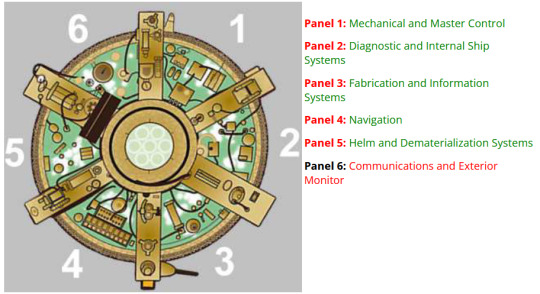
[Image ID: On the left is a top-down diagram of the 9th and 10th Doctor's coral theme TARDIS, divided into six panel sections. Each section is labelled from 1-6 clockwise starting from the 12 o'clock position. On the right is a text list of the panels and their names: Panel 1: Mechanical and Master Control, Panel 2: Diagnostic and Internal Ship Systems, Panel 3: Fabrication and Information Systems, Panel 4: Navigation, Panel 5: Helm and Dematerialisation Systems, Panel 6: Communications and Exterior Monitor./.End ID]
See this page on the TARDIS Technical Index for more variations on desktop themes.
👨✈️ Roles and Responsibilities
Here's a breakdown of each potential role and their responsibilities:
🔧 Panel 1: Mechanical and Master Control
Role: Chief Engineer
Responsibilities: The chief engineer monitors the TARDIS's overall operation. They ensure that all the mechanical systems and master controls are working properly. If anything goes wrong, they step in and fix it.
🛠️ Panel 2: Diagnostic and Internal Ship Systems
Role: Systems Analyst
Responsibilities: This person is all about the internals. They monitor life support, environmental controls, and the internal power grid. Basically, they make sure everything inside the TARDIS is working as it should.
🖥️ Panel 3: Fabrication and Information Systems
Role: Data Specialist
Responsibilities: Managing the TARDIS’s databases and info systems, and handling any fabrication needs. Whether it’s creating new tools, repairing old ones, or just making sure the information systems are up-to-date, they’ve got it covered.
🧭 Panel 4: Navigation
Role: Navigator
Responsibilities: Plotting courses through time and space. The Navigator makes sure the TARDIS lands where it’s supposed to, calculating all those tricky temporal vectors and spatial positions. They work closely with the Pilot to make sure the journey is smooth and safe.
🚀 Panel 5: Helm and Dematerialisation Systems
Role: Pilot
Responsibilities: This is the person at the helm, controlling take-off, landing, and in-flight manoeuvres. They handle the dematerialisation and rematerialisation of the TARDIS, making sure it takes off and lands without a hitch.
📡 Panel 6: Communications and Exterior Monitor
Role: Communications Officer
Responsibilities: They handle all external communications and keep an eye on what’s going on outside, involving sending or receiving messages or watching out for any threats or anomalies.
🏫 So...
Potentially, each Time Lord on the TARDIS would have a specialised role associated with a specific panel. Ideally, they're probably all working together like a well-oiled machine. However, poor old solo pilots have to jump around like madmen trying to cover all the controls at once.
Related:
🤔|🛸🧬The Life Cycle of a TARDIS: How TARDISes are born, grow, and die.
💬|🛸🧑✈️Do all TARDIS models require a 6-Person crew?: Piloting through the ages.
💬|🛸🌌Can a TARDIS be altered for travel in the multiverse?: How you might go about getting to the multiverse in your TARDIS.
Hope that helped! 😃
Any orange text is educated guesswork or theoretical. More content ... →📫Got a question? | 📚Complete list of Q+A and factoids →📢Announcements |🩻Biology |🗨️Language |🕰️Throwbacks |🤓Facts → Features: ⭐Guest Posts | 🍜Chomp Chomp with Myishu →🫀Gallifreyan Anatomy and Physiology Guide (pending) →⚕️Gallifreyan Emergency Medicine Guides →📝Source list (WIP) →📜Masterpost If you're finding your happy place in this part of the internet, feel free to buy a coffee to help keep our exhausted human conscious. She works full-time in medicine and is so very tired 😴
#doctor who#gallifrey institute for learning#dr who#dw eu#gallifrey#gallifreyans#whoniverse#ask answered#tardis#GIL: Asks#gallifreyan culture#gallifreyan lore#gallifreyan society#GIL: Gallifrey/Culture and Society#GIL: Gallifrey/Technology#GIL: Species/TARDISes#GIL: Species/Gallifreyans#GIL
44 notes
·
View notes
Text
PSA- Don’t Buy Tesla’s
“She told NBC6 that her husband would be still alive if the Model S door handles simply opened the car. That did not happen in Jutha’s Model Y, because its doors work with electronic actuators. If an electrical failure occurs, they demand a mechanical manual release.”
“Tesla has transitioned to an electromechanical door latch system on its vehicles, which means the doors are not physically connected to the door opening handles. Instead, these are electrical switches that trigger the electric door release system to open the door. Because there is no physical connection between the door handles and the door latching mechanism, it doesn’t work when the 12-volt electrical system is down for some reason.
This usually happens in the case of a crash. At least two car crashes ended with fatalities because people got trapped inside a Tesla.”
“‘Uggh, it's a Tesla. We can't get in these cars,’ one firefighter reportedly said. Despite the difficulty, they acted swiftly, using an ax to smash a window and rescue the child.”
“The Hyundai Venue compact SUV topped iSeeCars’ review of National Highway Traffic Safety Administration Fatality Analysis Reporting System data for most dangerous cars, while Tesla topped its list of most dangerous car brands.”
“These fires burn at much higher temperatures and require a lot more water to fight than conventional car fires. There also isn’t an established consensus on the best firefighting strategies for EVs, experts told Vox.”

Seriously- no matter what your political leanings are- DON’T BUY TESLA’S; the fact that no one is widely discussing a very blatant safety risk that people can’t reliably get out of their cars during a car accident is HORRIBLE…
If you KNOW someone who owns a Tesla- make sure they are AWARE of this flaw in certain vehicles and that they should possibly purchase a window breaker to be safe.
#If you hate Musk…. Please feel free to reblog…#Tesla#tesla cars#Elon Musk#fraud#Cars#car safety#automotive#electric vehicles#electric cars#psa#please share#please reblog#please boost#please spread
12 notes
·
View notes
Text
Jelpax/Drax i(Jeldrax) s the ultimate ship besides Gothrusa.
I wrote a fast SFW fic for the three people that care lol: (warning not beta read I’m sorry, I am lazy and lonely)
Enjoy!
*********
Drax was in shock.
Complete and utter shock.
The keys in his hand were real…*right*?
“Pax…I…” Drax whispered, softly. He felt warm tears for the first time in years well up in his eyes.
“Its rent is covered for a year. I was able to get a good deal and cash a stock or three that my Housefather took out when I began schooling.” Jelpax smiled, holding his gloved hand.
The keys were to an empty old small mechanic shop that had been emptied out. The lights flickered and the paint definitely needed updated but, it was all Drax’s.
“Pax…I don’t even know how to begin to thank you.” Drax sniffled, hugging his handsome coordinator.
“Just promise me you pay the bills and taxes on time alright? If you need help just ask. You know that the High Council has people that do check in on us, okay?” Jelpax asked, glancing out the windows for witnesses before kissing the top Drax’s hat covered head.
“I am going to be a model citizen! You would think I passed Borusa’s advanced civics classes with honors! I think I can make a profit too. I can start spoiling my Jelpax, yes?” Drax smiled.
“Perhaps, but even if you don’t I think it will keep you busy and happier than you working at that awful parts store.” Jelpax explained.
Drax had worked at a local skimmer parts store for nearly 100 years after dropping out from the academy. Jelpax had concern especially when his Drax’s direct deposit would bounce or his expensive personal equipment and tools “missing”. Jelpax had reported the shop dozens of times anonymously through his own government connections, but nothing was ever truly done.
Now Drax could provide services and fill an important niche in the industry by providing regular maintenance and repairs.
The orange light from the setting suns lit the shop in a warm golden glow. Drax once more looked at the keys and smiled. He was going to make Jelpax proud.
*******
“You are letting an academy dropout run his own workshop? That you solely invested in?!” Lord Borusa asked Coordinator Jelpax sternly.
They had met to go over recent happenings in a few quadrants of space that Coordinator Jelpax managed but, like always, conversation on their own personal lives were eventually held over tea and a light snack in Lord Borusa’s office.
“Yes…I did. I know it is not logical sir but, I never felt right seeing Drax go off to work in that shop. He had two bounced paychecks last year alone!” Jelpax explained. Lord Borusa could see the carefully concealed anger brewing beneath Jelpax’s cool and collected demeanor. He, more than anyone, knew how much Drax meant to Jelpax.
“I see. Well. I suppose, as long as he inputs the data correctly, the accounting system will handle things.” Borusa muttered taking another sip of tea; he was wishing deeply that it was wine.
“More importantly, it will keep him busy and out of trouble while I am here helping you and others. My portfolio is very good, Sir. I took the economics classes seriously. He can lose quite a lot before I will shut it down. It is cheaper than funding a lawyer for a felony in street racing.” Jelpax smiled, taking another sip of his own tea.
“‘Fund the passion early so the passion does not become a liability’…that is your argument?”
“Yes, Lord Borusa.”
The Cardinal paused for a moment, reflecting on the current Timelord he shared a bed with off the record.
“Coordinator…you may just be one of the most brilliant in our chapter.” Lord Borusa remarked. Jelpax grinned.
“Thank you, Lord Borusa.”
#the deca#jelpax#Drax doctor who#Jelpax doctor who#doctor who academy era#Borusa mention because I’m dumb#Drax#Jeldrax#Doctor who fanfiction#doctor who#Dr who#Dr who fanfic
8 notes
·
View notes
Text










Digimon Data Squad (Savers) - Episode 14
Wow, this episode kinda popped off. I was skeptical at first because there were a lot of wonky/off model shots in the first half, but the fight animation was great! Overall this episode had super snappy pacing and I was on the edge of my seat. Looks like this arc's gonna be good!
Notes:
I can't tell if it's just my imagination, but sometimes it looks like they're using 3DCG for Agumon and Gaomon (outside of digivolution sequences I mean). I keep getting thrown off by how derpy they look. (Maybe it's just how they're shaded?)

It was pretty satisfying when Masaru's mom confirmed that she knew about digimon all along and that's why she wasn't that surprised about Agumon. Brings some perspective/context for earlier episodes and gives this season some rewatch value.
Masaru's dad face reveal! He has his son's curtain bangs lol. Their skin tone is the same too.
We finally see Yoshi at home. Her room is pretty generic. I was kinda hoping they made it a mess as a call back to what Lalamon said about Yoshi being a slob earlier
I find it funny that Sayuri's signature dish is just fried eggs. Finally some achievable mom standards!
Loved the chunky, clunky tools DATS came up with for the journey to the digital world. One of which looks like an 90s cell phone

Love Ikuto. First of all, we haven't really seen this "feral child" concept yet, so he doesn't feel like a rehash of past characters. His design is really strong (kinda reminds me of this obscure manga I used to read called +Anima) and his way of speaking is fun too. I like how he says "humon" in the dub, that's genius. Finally, his fight scene was just really fun to watch.
Can't decide if Peckmon is hilarious or awesome. Either way I got really excited when they revealed him. He's ostrich-sized and kind of like a weird, ninja chocobo. His hair and color scheme is giving me "1980s shounen" vibes. Fascinating.
Sunflowmon continues to be pretty worthless every time 😬
Still hate Jureimon. He's definitely up there in my "top 10 worst digimon designs" list that I store in my brain. At list his Nyokimon were cute.
Was that Gotsumon supposed to be possessed/brainwashed when he was attacking everyone? His eyes got all glowy so I assume that's what they were going for. ~Mysterious~
17 notes
·
View notes
Text

Beginner Blender Tutorial Basic Render: Part One (Importing a Sim and Adjusting Textures)
To learn the basics, we'll begin with a super simple render: one sim, one pose, one background.
But first, the anatomy of blender.
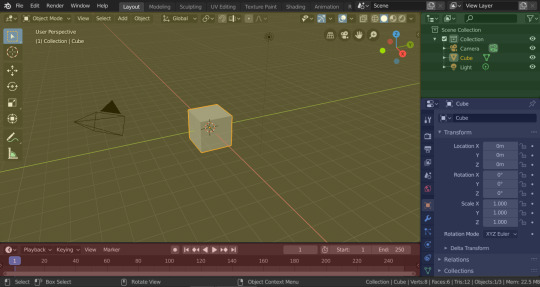
(image & list courtesy of Blender's online manual)
Yellow - 3D viewport (workspace) The 3D Viewport is used to interact with the 3D scene for a variety of purposes, such as modeling, animating, texture painting, etc.
Green - Outliner The Outliner is a list that organizes data in the blend-file, i.e. the scene data, Video Sequencer data, or anything that gets stored in a blend-file.
Blue - Properties The Properties shows and allows editing of many active data, including the active scene and object.
Red - Timeline The Timeline editor, identified by a clock icon, is used for manipulating keyframes and scrubbing the Playhead.
The tools I use most I've highlighted below:
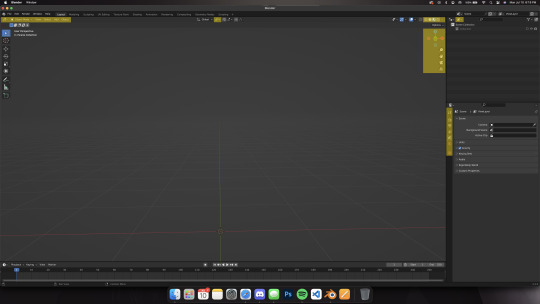
I won't outline their uses just now, but we'll be going over them as we use them.
Different creators like to split their blender window up in different ways, but this is my preferred setup when I'm working:
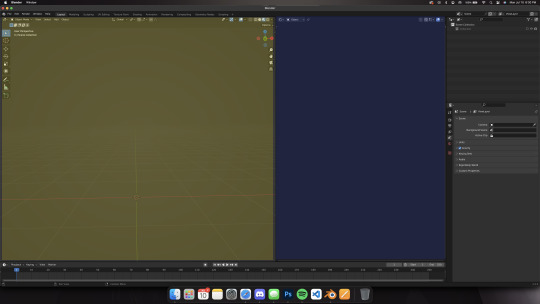
I use the yellow half of the screen as a render preview/3D workspace
I use the blue half for shader editing, posing, etc.
You can set yours up like mine or find what's comfortable for you.
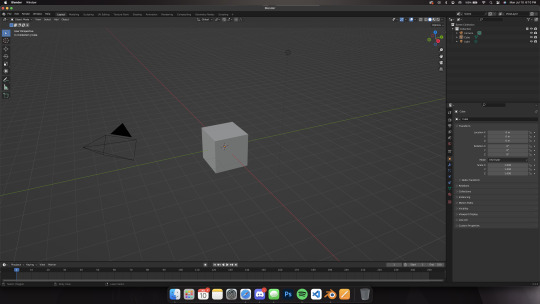
When you first open blender, you'll be greeted by the default cube, lamp, and camera.
Delete them! You can do this two ways:
Click and drag your mouse over all 3 and delete or Select all 3 in the side menu and hit x on your keyboard
Step 1: Importing our Sim
After deleting the default items, we'll import our sim. This tutorial assumes you've already ripped your sim (if you haven't, check here for how to do so!)
Now, let's import.
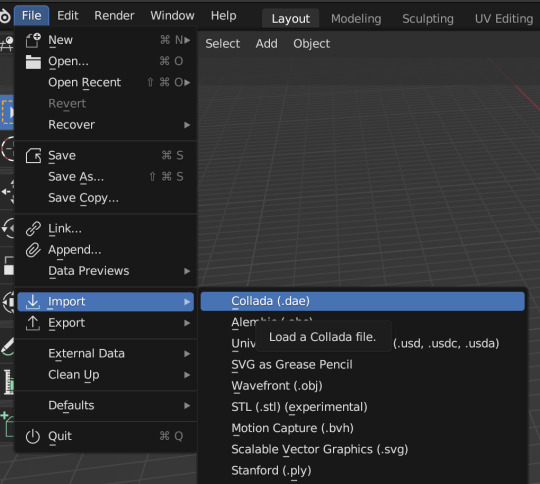
Click file -> import -> collada (dae) Select your DAE and click "import"
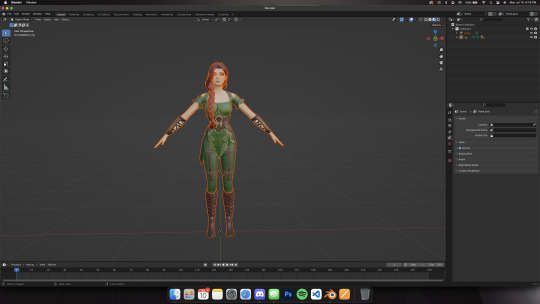
Your sim will look a little... off (thick eyelashes and a weird shine), but that's okay we're going to fix it! Your sim might also look solid white. If that's the case, make sure you're in the right mode. You can adjust modes by clicking on one of the four circles in the top right of the screen.

These are your viewport modes.
Wireframe (far left) - good for mesh editing Solid (middle left) - good for posing Material Preview (middle right) - what we work in most, shows everything with textures (color) Rendered (far right) - this shows your render preview We'll be working mostly in Material Preview
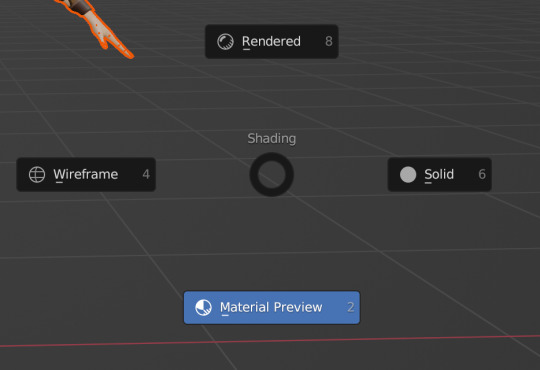
You can also switch between modes by hitting z on your keyboard then selecting which one you want I'll be using mostly keyboard shortcuts but I'll show you how to do both as we go along
Step 2: Adjusting Our Sim's Textures
Let's fix our sim's textures.
First. set up your workspace. Separate your workspace into two windows (as shown in the picture above with a yellow half and a blue half) and select "shader editor" in your right-side window. Like this:

Next, navigate to your Outliner and click the little dropdown beside "rig"

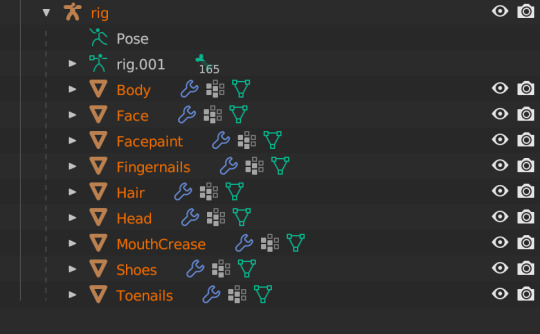
Under "rig" you'll see your sim's body parts listed. We're going to select "Body" When we click "Body", these colored blocks will appear in our shader editor window.

These are called Nodes. We use Nodes to adjust textures for various items in blender (sims, walls, furniture, etc). To add a new Node, you can select "add" in the top bar, or hit Shift+A on your keyboard and add in the node you need.


We're going to add in a Mix Shader and a Transparent Shader (both found under the Shader tab) and adjust our nodes this way:

Snug the Mix Shader between the Principled BSDF and the Material Output. Now we have to connect our Nodes and adjust our Principled BSDF. For the sake of this tutorial, I'll show the basic Node & Shader adjustments, but we'll go into each of them in a later tutorial.
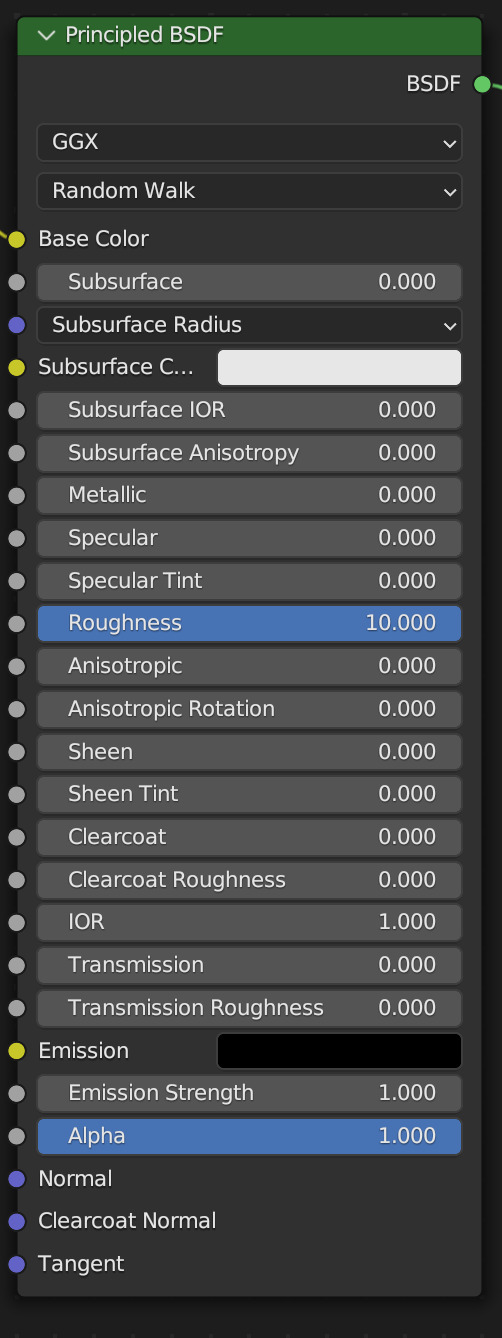
Adjust your Principled BSDF like this, then connect your Node lines exactly like this:
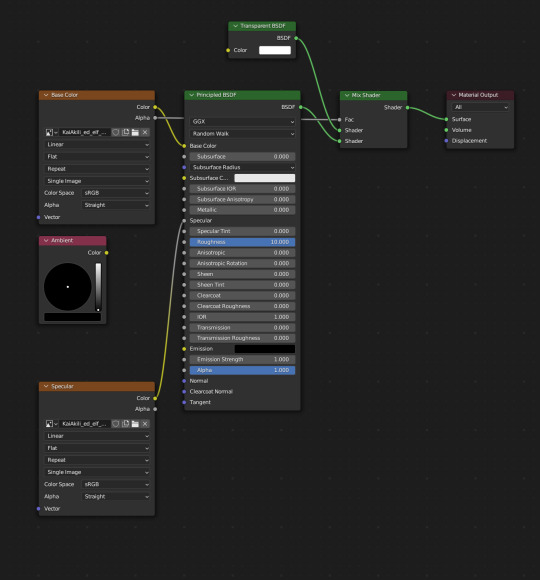
You'll see that our SIm's body looks a bit different from her head, hair and shoes. That's good! Now we need to duplicate that texture to the rest of our sim.
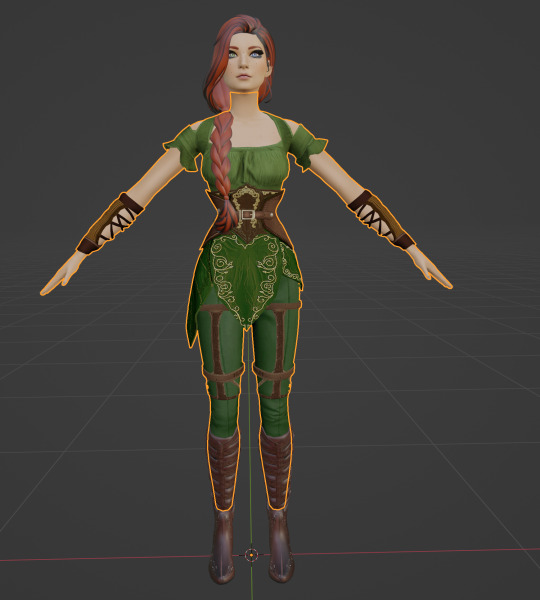
Navigate to your Outliner again, and use Shift+Click to select the rest of the body parts in the list Don't select pose or rig.001 and make sure the Body is selected first EDIT: You'll only see "body" if your sim has a full body outfit on! If they have a shirt and pants, you'll have "Bottom" and "Top" instead! In this case, select "bottom"!

Now, hover your cursor over your sim/the 3D viewport window, and press Ctrl+L on your keyboard. This brings up the Link/Transfer data window. Select "Link Materials"
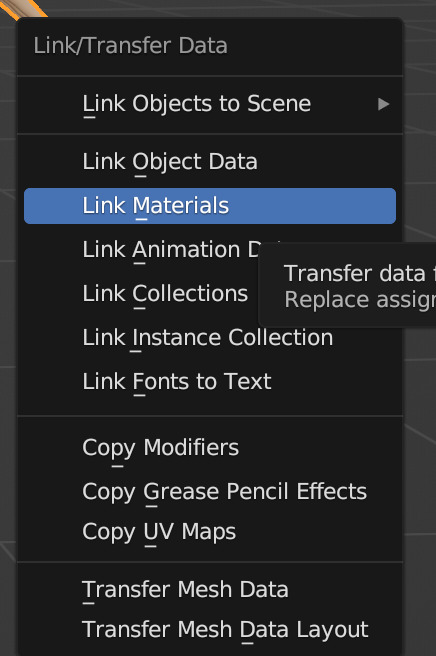
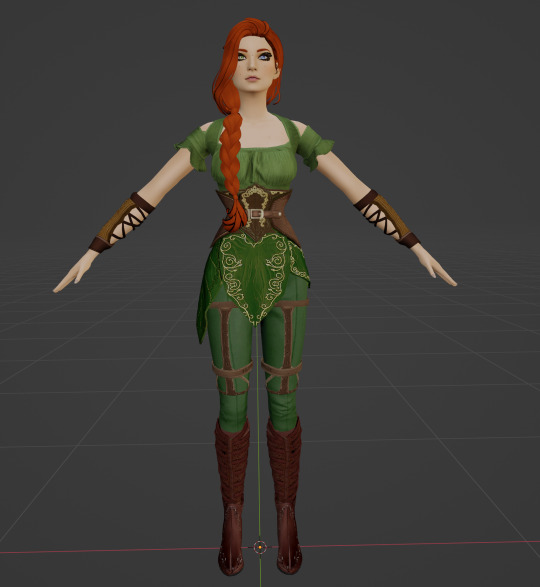
Our sim is looking better, but her eyelashes are still dark, let's fix that now.

In your Properties area, navigate to Material Properties (the little red ball)
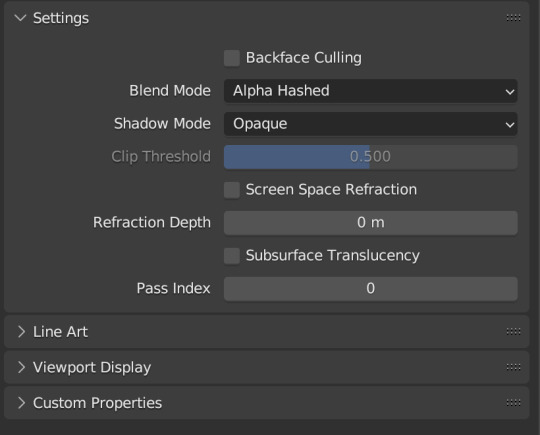
Change your Blend Mode to Alpha Hashed We will always set Blend Mode to Alpha Hashed
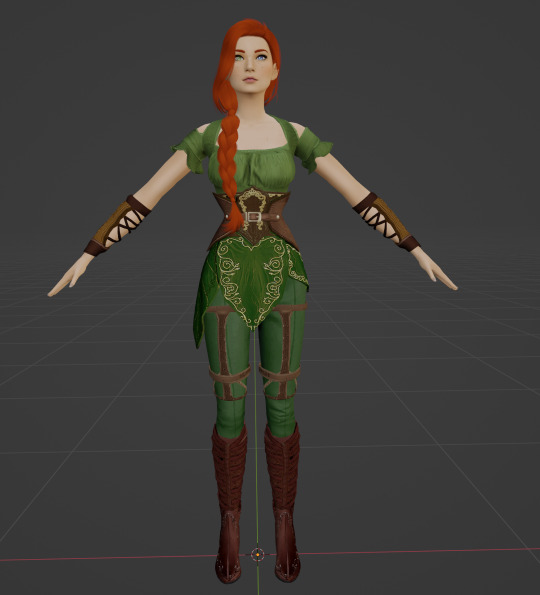
Now our sim looks right!
In Part Two, we'll pose her, set up the scene, and run the render!
#salemsims tutorial#render school tutorial#sims 4 render tutorial#sims 4 blender tutorial#blender#render tutorial#sims render tutorial
159 notes
·
View notes
Note
i think also a huge part of why artists majorly refuse machine-learning (bc that’s what it is, i refuse to call it ai bc it’s inaccurate and gives tech bros too much credit) is that the people currently championing and developing those tools actively want it to replace artists. They loudly and proudly hate the arts and want every creative professional put out of work. They want every creative HOBBYIST to give up. I have seen machine-learning art generators call us artoids (like ‘femoids’ incels or unhealthily online misogynists use to refer to women. To give you the idea of the kind of hate-fueled superiority we’re dealing with) and circle-jerk to the idea of art no longer being a career and no one being able to ask for commissions anymore.
Machine-learning tools are currently a symbol of people who see creativity and art as an enemy, a boogeyman to be slain. They are designed accordingly - stealing human work to create the data, designing it so that people can generate ‘sketches’ or ‘doodles’ to deceive the layman that it was hand-drawn, using real-world likenesses without consent, etc. When tech bros get tired of weaponizing machine-learning because they think we need to get ‘real jobs’ or that furry porn artists charge too much for comms and need to be stopped, it will probably be a lot easier for artists to embrace it as it’ll be a lot easier to develop ethical tools. On top of making development easier, it could become a great tool to make the visual arts accessible for people that have disabilities affecting drawing ability. It could be a wonderful technology.
But as it stands we’re not there yet.
WHATTTT.... ARTOIDS 💀.............................. that is THE most cringe fucking word ever im gonna start calling them fucking inceloids or something
Arent these the people who also have hentai addictions and collect all sorts of images of anime women breasting boobily? Do they think before AI that those images just popped up from the aether? They should also get real jobs that arent living in their moms basements and being a hateful little bitch
It's kind of hilarious that they think machine learning models will be the the end of art though. As if art hasnt been a core human function from prehistoric age and as if it hasnt survived hundreds of purges, demonizations, and attempts to erase certain styles and movements and people. We're going to prevail no matter what and they can die mad about it
#i think every ai tech bro should be strapped to several sticks of dynamite and exploded like fireworks#ask#anon#ai#i do agree with you on calling it ai im gonna stop using that but i will keep the tag for simplicitys sake#since its what people use the most. but you make an excellent point of it just being machine learning. cause it is#the thing that gets me is how these generated images are literally what people thought digital art was like five.. ten years ago#just click a button and make an art. nevermind learning the tools and the fact you DO have to draw it#i think people who were against digital art should hardcore come back to be against generated images like this. THIS Is their boogeyman
77 notes
·
View notes
Text
Things That Are Hard
Some things are harder than they look. Some things are exactly as hard as they look.
Game AI, Intelligent Opponents, Intelligent NPCs
As you already know, "Game AI" is a misnomer. It's NPC behaviour, escort missions, "director" systems that dynamically manage the level of action in a game, pathfinding, AI opponents in multiplayer games, and possibly friendly AI players to fill out your team if there aren't enough humans.
Still, you are able to implement minimax with alpha-beta pruning for board games, pathfinding algorithms like A* or simple planning/reasoning systems with relative ease. Even easier: You could just take an MIT licensed library that implements a cool AI technique and put it in your game.
So why is it so hard to add AI to games, or more AI to games? The first problem is integration of cool AI algorithms with game systems. Although games do not need any "perception" for planning algorithms to work, no computer vision, sensor fusion, or data cleanup, and no Bayesian filtering for mapping and localisation, AI in games still needs information in a machine-readable format. Suddenly you go from free-form level geometry to a uniform grid, and from "every frame, do this or that" to planning and execution phases and checking every frame if the plan is still succeeding or has succeeded or if the assumptions of the original plan no longer hold and a new plan is on order. Intelligent behaviour is orders of magnitude more code than simple behaviours, and every time you add a mechanic to the game, you need to ask yourself "how do I make this mechanic accessible to the AI?"
Some design decisions will just be ruled out because they would be difficult to get to work in a certain AI paradigm.
Even in a game that is perfectly suited for AI techniques, like a turn-based, grid-based rogue-like, with line-of-sight already implemented, can struggle to make use of learning or planning AI for NPC behaviour.
What makes advanced AI "fun" in a game is usually when the behaviour is at least a little predictable, or when the AI explains how it works or why it did what it did. What makes AI "fun" is when it sometimes or usually plays really well, but then makes little mistakes that the player must learn to exploit. What makes AI "fun" is interesting behaviour. What makes AI "fun" is game balance.
You can have all of those with simple, almost hard-coded agent behaviour.
Video Playback
If your engine does not have video playback, you might think that it's easy enough to add it by yourself. After all, there are libraries out there that help you decode and decompress video files, so you can stream them from disk, and get streams of video frames and audio.
You can just use those libraries, and play the sounds and display the pictures with the tools your engine already provides, right?
Unfortunately, no. The video is probably at a different frame rate from your game's frame rate, and the music and sound effect playback in your game engine are probably not designed with syncing audio playback to a video stream.
I'm not saying it can't be done. I'm saying that it's surprisingly tricky, and even worse, it might be something that can't be built on top of your engine, but something that requires you to modify your engine to make it work.
Stealth Games
Stealth games succeed and fail on NPC behaviour/AI, predictability, variety, and level design. Stealth games need sophisticated and legible systems for line of sight, detailed modelling of the knowledge-state of NPCs, communication between NPCs, and good movement/ controls/game feel.
Making a stealth game is probably five times as difficult as a platformer or a puzzle platformer.
In a puzzle platformer, you can develop puzzle elements and then build levels. In a stealth game, your NPC behaviour and level design must work in tandem, and be developed together. Movement must be fluid enough that it doesn't become a challenge in itself, without stealth. NPC behaviour must be interesting and legible.
Rhythm Games
These are hard for the same reason that video playback is hard. You have to sync up your audio with your gameplay. You need some kind of feedback for when which audio is played. You need to know how large the audio lag, screen lag, and input lag are, both in frames, and in milliseconds.
You could try to counteract this by using certain real-time OS functionality directly, instead of using the machinery your engine gives you for sound effects and background music. You could try building your own sequencer that plays the beats at the right time.
Now you have to build good gameplay on top of that, and you have to write music. Rhythm games are the genre that experienced programmers are most likely to get wrong in game jams. They produce a finished and playable game, because they wanted to write a rhythm game for a change, but they get the BPM of their music slightly wrong, and everything feels off, more and more so as each song progresses.
Online Multi-Player Netcode
Everybody knows this is hard, but still underestimates the effort it takes. Sure, back in the day you could use the now-discontinued ready-made solution for Unity 5.0 to synchronise the state of your GameObjects. Sure, you can use a library that lets you send messages and streams on top of UDP. Sure, you can just use TCP and server-authoritative networking.
It can all work out, or it might not. Your netcode will have to deal with pings of 300 milliseconds, lag spikes, package loss, and maybe recover from five seconds of lost WiFi connections. If your game can't, because it absolutely needs the low latency or high bandwidth or consistency between players, you will at least have to detect these conditions and handle them, for example by showing text on the screen informing the player he has lost the match.
It is deceptively easy to build certain kinds of multiplayer games, and test them on your local network with pings in the single digit milliseconds. It is deceptively easy to write your own RPC system that works over TCP and sends out method names and arguments encoded as JSON. This is not the hard part of netcode. It is easy to write a racing game where players don't interact much, but just see each other's ghosts. The hard part is to make a fighting game where both players see the punches connect with the hit boxes in the same place, and where all players see the same finish line. Or maybe it's by design if every player sees his own car go over the finish line first.
50 notes
·
View notes
Text
*thousand yard stare at the frozen and helsa fandom for churning out AI art crap*

Please cut that shit out. I’m begging you. You are ruining search engines and clogging up the tags. The fun novelty of creating images from stolen data is making our lives as artists harder than they should be. It’s discrediting the labor that sustains our livelihood and it does not come without a cost; just creating one image can use much energy as charging your phone, and from this MIT report, “Generating 1,000 images with a powerful AI model, such as Stable Diffusion XL, is responsible for roughly as much carbon dioxide as driving the equivalent of 4.1 miles in an average gasoline-powered car.” Now multiply that by the thousands of people who think this is okay. It’s wasting power and increasing carbon emissions on top of every other factor that’s ruining the environment.
Listen, novelty is fun. Before I knew more about it, I tried it out myself and initially I thought it could be useful, but as always, there is no free lunch. There is a cost to doing this and it is a detriment to our society and ecosystem. Jobs are at stake here and this tool is plagiarizing off the backs of hardworking creatives and other members of the labor force.
Please stop using AI, or at least try to use it more conservatively. Thank you.
#helsa#frozen#frozen 2#disney#prince hans#queen elsa#artists on tumblr#fuck ai art#fuck ai everything
32 notes
·
View notes
Text


How did the building blocks of life arrive on Earth? Zinc fingerprints in meteorites offer clues
Researchers have used the chemical fingerprints of zinc contained in meteorites to determine the origin of volatile elements on Earth. The results suggest that without 'unmelted' asteroids, there may not have been enough of these compounds on Earth for life to emerge.
Volatiles are elements or compounds that change into vapor at relatively low temperatures. They include the six most common elements found in living organisms, as well as water. The zinc found in meteorites has a unique composition, which can be used to identify the sources of Earth's volatiles.
The researchers, from the University of Cambridge and Imperial College London, have previously found that Earth's zinc came from different parts of our solar system: about half came from beyond Jupiter and half originated closer to Earth.
"One of the most fundamental questions on the origin of life is where the materials we need for life to evolve came from," said Dr. Rayssa Martins from Cambridge's Department of Earth Sciences. "If we can understand how these materials came to be on Earth, it might give us clues to how life originated here, and how it might emerge elsewhere."
Planetesimals are the main building blocks of rocky planets, such as Earth. These small bodies are formed through a process called accretion, where particles around a young star start to stick together, and form progressively larger bodies.
But not all planetesimals are made equal. The earliest planetesimals that formed in the solar system were exposed to high levels of radioactivity, which caused them to melt and lose their volatiles. But some planetesimals formed after these sources of radioactivity were mostly extinct, which helped them survive the melting process and preserved more of their volatiles.
In a study published in the journal Science Advances, Martins and her colleagues looked at the different forms of zinc that arrived on Earth from these planetesimals.
The researchers measured the zinc from a large sample of meteorites originating from different planetesimals and used this data to model how Earth got its zinc, by tracing the entire period of the Earth's accretion, which took tens of millions of years.
Their results show that while these 'melted' planetesimals contributed about 70% of Earth's overall mass, they only provided around 10% of its zinc.
According to the model, the rest of Earth's zinc came from materials that didn't melt and lose their volatile elements. Their findings suggest that unmelted, or 'primitive' materials were an essential source of volatiles for Earth.
"We know that the distance between a planet and its star is a determining a factor in establishing the necessary conditions for that planet to sustain liquid water on its surface," said Martins, the study's lead author. "But our results show that there's no guarantee that planets incorporate the right materials to have enough water and other volatiles in the first place – regardless of their physical state."
The ability to trace elements through millions or even billions of years of evolution could be a vital tool in the search for life elsewhere, such as on Mars, or on planets outside our solar system.
"Similar conditions and processes are also likely in other young planetary systems," said Martins. "The roles these different materials play in supplying volatiles is something we should keep in mind when looking for habitable planets elsewhere."
TOP IMAGE: An iron meteorite from the core of a melted planetesimal (left) and a chondrite meteorite, derived from a 'primitive', unmelted planetesimal (right). Credit: Rayssa Martins/Ross Findlay
LOWER IMAGE: An iron meteorite from the core of a melted planetesimal (left) and a chondrite meteorite, derived from a 'primitive', unmelted planetesimal (right). Credit: Sedgwick Museum of Earth Sciences, University of Cambridge.
6 notes
·
View notes
Text
Europe’s most famous privacy activist, Max Schrems, landed another blow against Meta today after the EU’s top court ruled the tech giant cannot exploit users’ public statements about their sexual orientation for online advertising.
Since 2014, Schrems has complained of seeing advertising on Meta platforms targeting his sexual orientation. Schrems claims, based on data he obtained from the company, that advertisers using Meta can deduce his sexuality from proxies, such as his app logins or website visits. Meta denies it showed Schrems personalized ads based on his off-Facebook data, and the company has long said it excludes any sensitive data it detects from its advertising operations.
The case started with Schrems challenging whether this practice violated Europe’s GDPR privacy law. But it took an unexpected turn when a judge in his home country of Austria ruled Meta was entitled to use his sexuality data for advertising because he had spoken about it publicly during an event in Vienna. The Austrian Supreme Court then referred the case to the EU’s top court in 2021.
Today, the Court of Justice of the European Union (CJEU) finally ruled that a person’s sexual orientation cannot be used for advertising, even if that person speaks publicly about being gay.
“Meta Platforms Ireland collects the personal data of Facebook users, including Mr. Schrems, concerning those users’ activities both on and outside that social network,” the court said. “With the data available to it, Meta Platforms Ireland is also able to identify Mr. Schrems’ interest in sensitive topics, such as sexual orientation, which enables it to direct targeted advertising at him.”
The fact that Schrems had spoken publicly about his sexual identity does not authorize any platform to process related data to offer him personalized advertising, the court added.
“Now we know that if you're on a public stage, that doesn't necessarily mean that you agree to this personal data being processed,” says Schrems, founder of the Austrian privacy group NOYB. He believes only a handful of Facebook users will have the same issue. “It's a really, really niche problem.”
The CJEU also ruled today Meta has to limit the data it uses for advertising more broadly, essentially setting ground rules for how the GDPR should be enforced. Europe’s privacy law means personal data should not be “aggregated, analyzed, and processed for the purposes of targeted advertising without restriction as to time and without distinction as to type of data,” the court said in a statement.
“It's really important to set ground rules,” says Katharina Raabe-Stuppnig, the lawyer representing Schrems. “There are some companies who think they can just disregard them and get a competitive advantage from this behavior.”
Meta said it was waiting for the CJEU’s judgment to be published in full. “Meta takes privacy very seriously and has invested over 5 billion Euros to embed privacy at the heart of all of our products,” Meta spokesperson Matt Pollard told WIRED. “Everyone using Facebook has access to a wide range of settings and tools that allow people to manage how we use their information."
Schrems has been a prolific campaigner against Meta since a legal challenge he made resulted in a surprise 2015 ruling invalidating a transatlantic data transfer system over concerns US spies could use it to access EU data. His organization has since filed legal complaints against Meta’s pay-for-privacy subscription model and the company’s plans to use Europeans’ data to train its AI.
“It's major for the whole online advertisement space. But for Meta, it's just another one in the long list of violations they have,” says Schrems, of this latest ruling. “The walls are closing in.”
6 notes
·
View notes
Text
Top 8 Applications of 3D Printing in Medical Industry

3D printing technology, with its highly customizable, responsive and material-saving features, is triggering profound changes in the medical field. Especially in the application of medical models, 3D printing technology shows unparalleled advantages and potential.
Furthermore, 3D printing technology, as an emerging additive manufacturing technology, has made breakthroughs in its application in the medical field in recent years. The application of 3D printing technology in the medical field is becoming more and more widespread. Through the layer-by-layer stacking of digital models, a variety of medical devices, prosthetics, orthotics and other aids, and even human organs, can be accurately printed.
1.Surgical preview model
With 3D printing technology, doctors can create surgical preview models to help them simulate operations before surgery, improving accuracy and safety.
It is important for medical workers to conduct preoperative planning for risky and difficult procedures. In the previous surgical preview process, medical workers often need to obtain the patient's data through CT, magnetic resonance imaging (MRI) and other imaging equipment, and then the two-dimensional medical image using software to convert into realistic three-dimensional data. Today, medical workers can use devices such as 3D printers to print 3D models directly. In this way, it not only can assist the doctor to carry out accurate surgical planning, improve the success rate of surgery, but also to facilitate the communication and exchange between medical workers and patients on the surgical program plan.
2.Surgical guide
Surgical guides can help the surgeon to accurately position and operate during surgery, reducing surgical errors and improving surgical outcomes.
As an auxiliary surgical tool during surgery, surgical guides can help medical workers to accurately implement surgical programmes. Currently, the types of surgical guides have included joint guides, spinal guides, oral implant guides, etc. With the help of 3D printed surgical guides, firstly, the 3D scanning technology can produce three-dimensional data on the patient's affected area, which allows the doctor to obtain the most realistic information, so as to better plan the surgery. Secondly, while making up for the shortcomings of the traditional surgical guide manufacturing process, the size and shape of the guide can also be adjusted as needed.In this way, different patients can have a guide plate that meets their real needs.
3.Dental applications
3D printing technology is also widely used in the field of dentistry to print personalized trays, moulds, etc., to help patients have better dental treatment.
The application of 3D printing in the dental field mainly focuses on the design and production of metal teeth, invisible braces, etc. The emergence of cutting-edge technology of 3D printing creates more possibilities for those who need orthodontic treatment to achieve personalized and customized braces. At different stages of orthodontic treatment, orthodontists need different sets of braces. With the help of 3D printing to create multiple sets of braces needed for orthodontic treatment, it not only helps the healthy development of teeth, but also reduces the cost of braces production. The significance of these digital technologies is that they are gradually making it less necessary for doctors to make models, dentures, etc. by hand, and returning more of their efforts to the diagnosis of oral diseases and the performance of oral surgery itself.
4.Rehabilitation medical equipment
Through 3D printing technology, a variety of rehabilitation medical devices, such as prosthetics and orthotics, can be created to help patients regain function.
The real value of 3D printing for orthopaedic insoles, bionic hands, hearing aids and other rehabilitation devices is not only to achieve accurate customization, but also to allow accurate and efficient digital manufacturing technology to replace the traditional production methods, reducing the cost of individual customized rehabilitation medical devices and shortening the production cycle. 3D printing process is diversified, and there is a wide range of 3D printing materials. SLA light-curing 3D printing technology has the advantage of being able to provide the most efficient and cost-effective 3D printing technology. SLA light-curing 3D printing technology is widely used in rapid prototyping by the medical device industry due to its advantages of fast processing speed, high precision, good surface quality of photosensitive resin material moulding and moderate cost.
5.Medical Equipment Cases
3D printing technology can also be used to create a variety of medical devices, such as surgical instruments and medical equipment, to improve the personalization and accuracy of medical devices.
Take the example of 3D printing for mass customized production in the hearing aid shell industry. In the traditional way, injection moulds need to be made from a model of the patient's ear canal. The final shape of the hearing aid is obtained by drilling sound holes and manually processing the plastic product. If a mistake is made during the process, the mould needs to be recreated. The process of making a hearing aid using a 3D printer, on the other hand, begins with the design of a silicone mould or impression of the patient's ear canal, a step that is done using a 3D scanner. CAD software is then used to convert the scanned data into a design file that can be read by the 3D printer. The designer can then use the software to modify the 3D image and create the final product shape.
6.Precision replication and personalization
3D printing technology is able to accurately restore a patient's anatomy and produce full-size, high-fidelity medical models based on the patient's CT, MRI and other imaging data. These models not only have extremely high geometric accuracy and surface quality, but also reflect the unique physiological characteristics of the patient, providing doctors with real and reliable references.
7.Teaching and training
3D printed medical models also play an important role in medical education and training. By printing out models of various typical cases, medical students can perform practical operations in a simulated surgical environment to enhance their surgical skills and resilience. At the same time, these models can also be used as teaching tools to help students better understand human anatomy and disease principles.
8.Scientific research and experimentation
In the field of medical research, 3D printed medical models also have important applications. Researchers can use these models to conduct experimental studies such as drug screening and biomechanical testing to explore new treatment methods and technologies. In addition, by printing tissue or organ models with specific physiological functions, they can also provide strong support for research in cutting-edge fields such as organ transplantation and regenerative medicine.
In summary, 3D printing technology has a wide and far-reaching significance in the application of medical models. It not only improves the accuracy and efficiency of medical services, but also promotes the innovative development of medical education, research and clinical practice. With the continuous progress of technology and the expansion of application scope, we have reason to believe that 3D printing will play a more important role in the future medical field.
#3d printing#3d printing services#3d printed#additive manufacturing#3d print#medical device machining#medical 3d printing#3d printed parts#3d printing materials market#3d printing market share
4 notes
·
View notes
Text
Python Libraries to Learn Before Tackling Data Analysis
To tackle data analysis effectively in Python, it's crucial to become familiar with several libraries that streamline the process of data manipulation, exploration, and visualization. Here's a breakdown of the essential libraries:
1. NumPy
- Purpose: Numerical computing.
- Why Learn It: NumPy provides support for large multi-dimensional arrays and matrices, along with a collection of mathematical functions to operate on these arrays efficiently.
- Key Features:
- Fast array processing.
- Mathematical operations on arrays (e.g., sum, mean, standard deviation).
- Linear algebra operations.
2. Pandas
- Purpose: Data manipulation and analysis.
- Why Learn It: Pandas offers data structures like DataFrames, making it easier to handle and analyze structured data.
- Key Features:
- Reading/writing data from CSV, Excel, SQL databases, and more.
- Handling missing data.
- Powerful group-by operations.
- Data filtering and transformation.
3. Matplotlib
- Purpose: Data visualization.
- Why Learn It: Matplotlib is one of the most widely used plotting libraries in Python, allowing for a wide range of static, animated, and interactive plots.
- Key Features:
- Line plots, bar charts, histograms, scatter plots.
- Customizable charts (labels, colors, legends).
- Integration with Pandas for quick plotting.
4. Seaborn
- Purpose: Statistical data visualization.
- Why Learn It: Built on top of Matplotlib, Seaborn simplifies the creation of attractive and informative statistical graphics.
- Key Features:
- High-level interface for drawing attractive statistical graphics.
- Easier to use for complex visualizations like heatmaps, pair plots, etc.
- Visualizations based on categorical data.
5. SciPy
- Purpose: Scientific and technical computing.
- Why Learn It: SciPy builds on NumPy and provides additional functionality for complex mathematical operations and scientific computing.
- Key Features:
- Optimized algorithms for numerical integration, optimization, and more.
- Statistics, signal processing, and linear algebra modules.
6. Scikit-learn
- Purpose: Machine learning and statistical modeling.
- Why Learn It: Scikit-learn provides simple and efficient tools for data mining, analysis, and machine learning.
- Key Features:
- Classification, regression, and clustering algorithms.
- Dimensionality reduction, model selection, and preprocessing utilities.
7. Statsmodels
- Purpose: Statistical analysis.
- Why Learn It: Statsmodels allows users to explore data, estimate statistical models, and perform tests.
- Key Features:
- Linear regression, logistic regression, time series analysis.
- Statistical tests and models for descriptive statistics.
8. Plotly
- Purpose: Interactive data visualization.
- Why Learn It: Plotly allows for the creation of interactive and web-based visualizations, making it ideal for dashboards and presentations.
- Key Features:
- Interactive plots like scatter, line, bar, and 3D plots.
- Easy integration with web frameworks.
- Dashboards and web applications with Dash.
9. TensorFlow/PyTorch (Optional)
- Purpose: Machine learning and deep learning.
- Why Learn It: If your data analysis involves machine learning, these libraries will help in building, training, and deploying deep learning models.
- Key Features:
- Tensor processing and automatic differentiation.
- Building neural networks.
10. Dask (Optional)
- Purpose: Parallel computing for data analysis.
- Why Learn It: Dask enables scalable data manipulation by parallelizing Pandas operations, making it ideal for big datasets.
- Key Features:
- Works with NumPy, Pandas, and Scikit-learn.
- Handles large data and parallel computations easily.
Focusing on NumPy, Pandas, Matplotlib, and Seaborn will set a strong foundation for basic data analysis.
6 notes
·
View notes